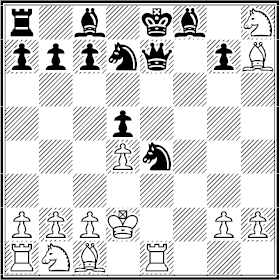
When the tactics level escalates dangerously, good players find a way to seek at least a draw.
Igor Zaitsev White
Anatoly Karpov Black
Leningrad 1966
Petroff Defense C43
1 e4 e5 2 ♘f3 ♘f6 3 d4 ♘xe4 4 ♗d3 d5 5 ♘xe5 ♘d7
Black’s last move was once considered an error because of 6 ♕e2. Then 6...♕e7? 7 ♗xe4 dxe4 8 ♗f4! is dubious.
But 6...♘xe5! is a sound gambit, 7 ♗xe4 dxe4 8 ♕xe4 ♗e6. See below.
6 ♘xf7
White finds a way to force a draw: 6...♔xf7 7 ♕h5+ ♔e7 (7...g6? 8 ♕xd5+) 8 ♕e2.
The threat of 9 f3 prompts 8...♔f7 when 9 ♕h5+ repeats the position.
Not 8...♔d6? 9 ♗f4+ ♔c6? 10 ♗xe4 dxe4 11 ♘c3 and 12 ♕b5 mate or 12 ♕c4+.
6...♕e7!?
And Black finds a way to play to win. The onus is back on White.
7 ♘xh8 ♘c3+
Not 7...♘g3+? 8 ♗e3! ♘xh1 9 ♕h5+! and Black is worse.
8 ♔d2 ♘xd1 9 ♖e1! ♘xf2 10 ♗xh7!
Now 10...♘f6 11 ♗g6+ ♔d7 12 ♖xe7+ is at least an extra pawn for White.
10...♘e4+

11 ♖xe4!
Black cannot escape perpetual check.
11...dxe4 12 ♗g6+ ♔d8 13 ♘f7+ ♔e8 14 ♘d6+ draw
White must agree to it because 14 ♔e2 is lost after 14...♕e6 or just 14...♕xf7.
Question 211: After 6...♕e7, did White have a legitimate way to play for a win?
Josef Klinger White
Patrick Wolff Black
Baguio City 1987
1 e4 e5 2 ♘f3 ♘f6 3 d4 ♘xe4 4 ♗d3 d5 5 ♘xe5 ♘d7 6 ♕e2 ♘xe5 7 ♗xe4 dxe4 8 ♕xe4 ♗e6 9 ♕xe5 ♕d7 10 ♗e3 ♗b4+ 11 c3 ♗d6 12 ♕a5 ♕c6! 13 0-0 ♗d5! 14 f3 b6 15 ♕a6 ♗c4 16 d5 ♕xd5 17 ♕a4+ b5 18 ♕d1 ♕e5! 19 ♔f2 ♕xh2 20 f4 ♗xf1 White resigns.